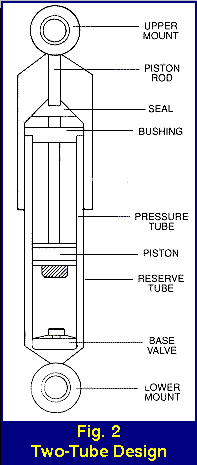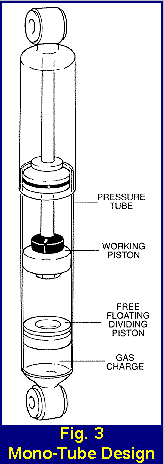SHOCK ABSORBER DESIGN
There are two basic shock absorber designs in use today: the two-tube design and the mono-tube design.
The conventional shock absorber is illustrated in Fig. 2. Notice that it has two tubes. The inner tube is known as the pressure or working cylinder, while the outer tube is known as the reserve tube. The outer tube is used to store excess fluid.
The upper mount of the shock absorber connects to the vehicle frame. This upper mount is called the piston rod, and at the bottom is the piston. Notice that this piston rod passes through a bushing and a seal at the upper end of the pressure tube. The bushing keeps the rod in line with the pressure tube and allows the piston to move freely inside. The seal keeps the hydraulic oil inside and contamination out. It’s usually of a multi-lip design made of neoprene or silicone rubber.
The base valve located at the bottom of the pressure tube is called a compression valve. It controls fluid movement during the compression cycle. The outside of the reserve tube forms the lower mounting of the shock.

Mono-Tube Design
Now let’s take a look at the mono-tube shock absorber design. These are high-pressure gas shocks with only one tube, the pressure tube.
If you look at Fig. 3, you’ll see that inside the pressure tube there are two pistons – one dividing piston and one working piston. The working piston and rod are very similar to the double tube shock design. The difference is that a mono-tube shock absorber can be mounted upside down or right side up and it will work either way. *NOTE A conventional two-tube shock absorber must be mounted somewhat vertically.
Another difference you might notice is that the mono-tube shock absorber does not have a base valve. Instead, all of the control during compression and extension takes place at the piston.
Actually, the shock body of the mono-tube design is much larger than needed to allow for suspension travel. A free floating diving piston travels in the lower end of the pressure tube, separating the gas charge and the oil.
The area below the dividing piston is pressurized to about 360 psi with nitrogen gas. This gas pressure tends to keep the rod extended. The oil is located in the area above the dividing piston.
* A mono-tube shock absorber improves unsprung mass when mounted upside down

